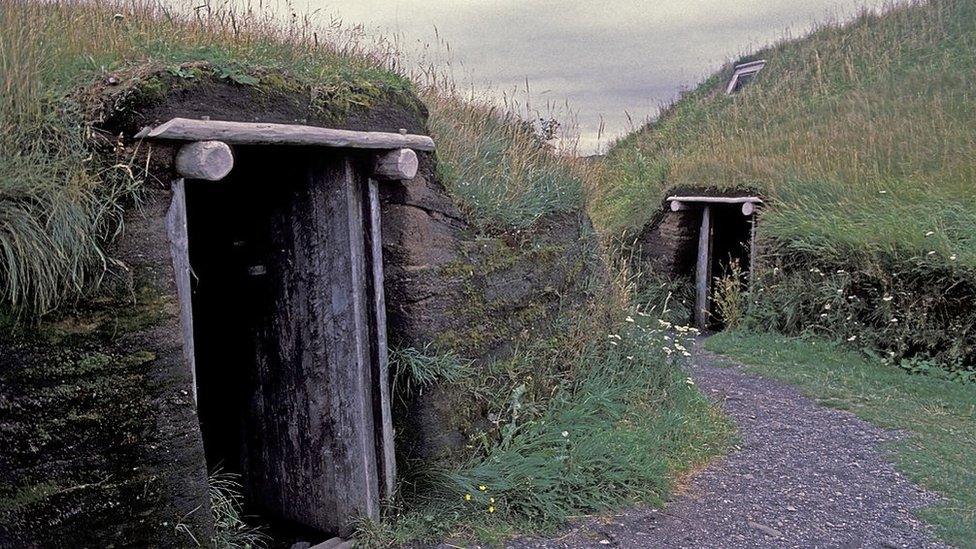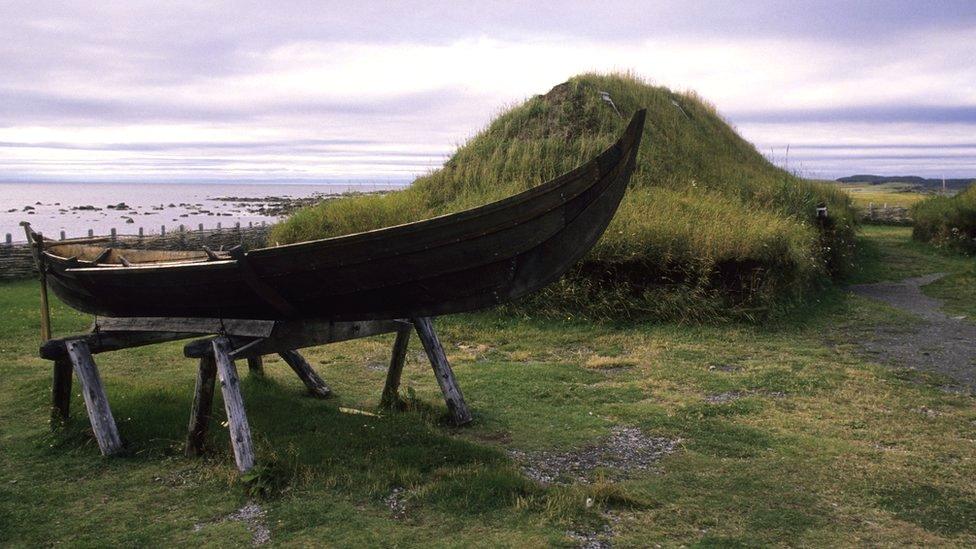Solar storm proves Vikings settled in North America 1,000 years ago
- Published
- comments

Vikings settled in North America exactly one thousand years ago and scientists used a solar storm from the Sun to figure it out.
Analysing three pieces of wood that had been used to build a settlement site in Newfoundland, Canada, scientists looked at tree rings, the markings on wood that shows the age of trees. The tree rings also provide evidence of things that have happened during the tree's life.
In 992AD, a burst of high energy from the Sun was absorbed by trees on Earth and, using the solar storm as a reference point, scientists were able to pinpoint the exact year the trees were cut down to 1021.

Vikings are thought to be the first European settlers in North America, reaching Newfoundland in Canada at least 1,000 years ago
Solar storms are a normal part of our Sun's solar cycle.
Sometimes described as solar flares or 'space weather', solar storms can reach Earth at different strengths and the energy from the Sun can create bright lights in the sky known as auroras.
In 992AD a writer in Saxony (modern-day Germany) wrote that "light like the Sun shone from the North."
Today stronger storms can interrupt radio communication and even cause power cuts, but fortunately scientists monitor the Sun to predict solar weather.
Watch this enormous solar flare from 2017
Who were the first Europeans in North America?
It's not known exactly who were the first European settlers in North America - but an Italian explorer known as Christopher Columbus often gets the credit for discovering the continent once described as the 'New World' in 1492.
However it has long been known that Europeans reached the Americas before Columbus's arrival, and this latest discovery places Vikings in Canada some 471 years before his famous voyage.
Previous estimates for the Viking camp at L'Anse aux Meadows site in Newfoundland was around 1000AD, but working out this exact date of 1021 doesn't necessarily mean Vikings weren't there earlier.

Replicas of Norse houses from 1,000 years ago at L'Anse aux Meadows in Newfoundland.
Dr Colleen Batey, a Viking expert with the Institute for Northern Studies in Scotland, said the research "suggests that the short-lived settlement was active in about 1021 when wood was being worked at the site, probably related to either building or ship repair.
"As an archaeologist, I might interpret this as one stage of the occupation activity, not necessarily the first or indeed the last."
L'Anse aux Meadows, is a Unesco world heritage site on the northernmost tip of the island of Newfoundland, and is the first and the only known site established by Vikings in North America and is currently the earliest evidence of European settlement in the New World.
The Viking age in European history was from about AD700 to 1100. During this period many Vikings left their homelands in Scandinavia and travelled by longboat to other countries including Britain and Ireland.
Some Vikings settled peacefully, but others weren't very friendly.
Using axes and swords they raided settlements stealing from churches and burning buildings to the ground.
The people of Britain called the invaders 'Danes', but they came from Norway and Sweden as well as Denmark.
Icelandic sagas - stories from Viking times that were written down over hundreds of years- speak of a leader named Leif Erikson and a settlement called "Vinland", assumed to be coastal North America.
Vikings are sometimes shown to have horns attached to their helmets, but this is thought to be historically inaccurate and the horns were instead used as drinking cups.

Replica Viking homes and other items at L'Anse aux Meadows, a Unesco world heritage site in Newfoundland, Canada
Working out the age of the settlement
Scientists studying the wood from the site in Canada said they had used a new technique that analysed an "atmospheric radiocarbon signal" produced by the solar storm in 992 as a reference point.
That sounds complicated, so here's how it works.
Radiocarbon dating is a technique used by experts to learn the age of things that used to be alive many years ago - for example, wood in artefacts or ancient human remains.
It can be used to work out the age of objects that are more than 50,000 years old.
Big Question: How does carbon dating work?
Carbon is an element that is found in every living thing on planet Earth. That's you and me, your pets, every living animal and the plants and trees outside.
One form of carbon inside living things is called carbon-14. Carbon-14 is a radioactive form of carbon, which might sound worrying, but it's not dangerous.
Scientists know how fast carbon-14 decays, so by measuring how much of it is left they can figure out how long something has been dead for.
So for the wood from the settlement, experts could work out the point when the tree had died after being cut down and worked backwards to the point where they had an exact reference point, the year when the tree's wood had been affected by the solar storm in 992.
- Published28 June 2020

- Published3 June 2020

- Published1 February 2012
